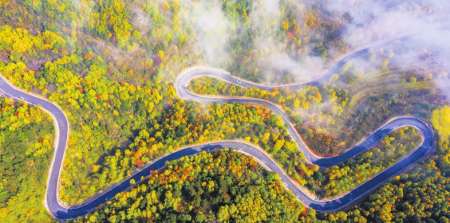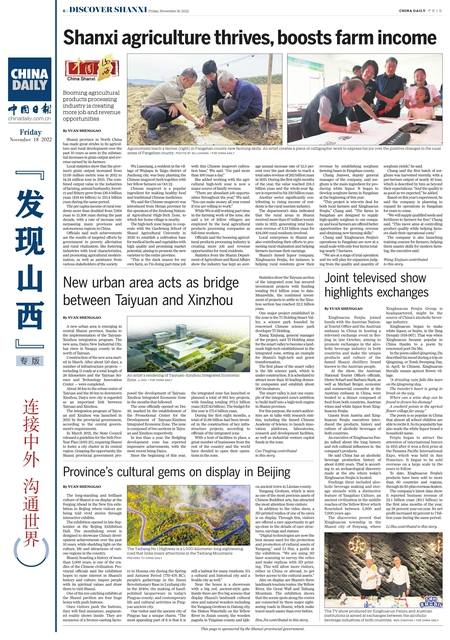Province’s cultural gems on display in Beijing

The Taihang No 1 Highway is a 1,000-kilometer-long sightseeing road that links major attractions in the Taihang Mountains. Provided to China Daily
The long-standing and brilliant culture of Shanxi is on display at the Forging Ahead in the New Era exhibition in Beijing where visitors are being told vivid stories through interactive exhibits.
The exhibition opened in late September at the Beijing Exhibition Hall. The monthslong event is designed to showcase China's development achievements over the past 10 years, while shedding light on the culture, life and attractions of various regions in the country.
Shanxi, boasting a history of more than 5,000 years, is one of the cradles of Chinese civilization. Provincial officials said the exhibition hopes to raise interest in Shanxi's history and culture, inspire people with its spiritual values and draw them to Shanxi.
One of the eye-catching exhibits at the Shanxi pavilion are four huge boxes with push buttons.
Once visitors push the buttons, they will find miniature, augmented reality shows inside. They are scenarios of a bronze-casting factory in Houma city during the Spring and Autumn Period (770-476 BC); people's gatherings in the Jinsui Revolutionary Base in Lyuliang city in the 1940s; the making of hand-polished lacquerware in today's Pingyao county; and contemporary life and cultural activities in Pingyao ancient city in the county.
One visitor said the ancient city of Pingyao has a unique charm. "The most appealing part of it is that it is still a habitat for many residents. It's a cultural and historical city and a livable city as well."
Near the boxes is a showroom with a big red, ancient-style gate. Inside there are five big screens that display Shanxi's landmark cultural sites and natural wonders including the Yungang Grottoes in Datong city, the Hukou Waterfalls on the Yellow River in Jixian county, the wooden pagoda in Yingxian county and Qikou ancient town in Linxian county.
Yungang Grottoes, which is seen as one of the most precious assets of Chinese Buddhist arts, has attracted the most attention from visitors.
In addition to the video show, a 3D-printed replica of one of its caves is on display. Through this, visitors are offered a rare opportunity to get up-close to the details of cave structures, carvings and statues.
"Digital technologies are now the best means for the protection and promotion of the cultural assets of Yungang," said Li Hui, a guide at the exhibition. "We are using 3D laser scanning to survey the relics and make replicas with 3D printing. This will allow more visitors, either in China or abroad, to get better access to the cultural assets."
Also on display are Shanxi's three landmark tourism routes: the Yellow River, the Great Wall and Taihang Mountains. The exhibition shows that the scenic spots along the routes are connected by three major sightseeing roads in Shanxi, which make travel much easier than ever before.
By Yuan Shenggao
Hou Jin contributed to this story.











